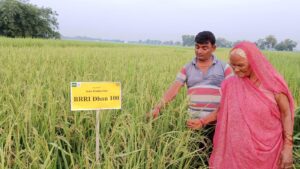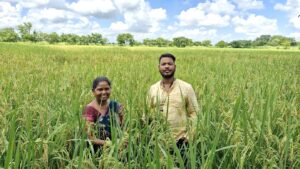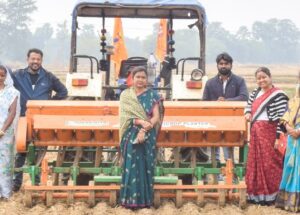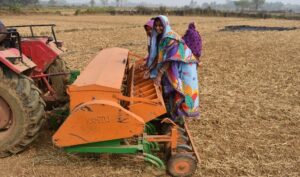
The International Rice Research Institute (IRRI) is recognizing another crop of Outstanding Alumni during an upcoming quadrennial ceremony. They are Amitha Bentota, Pham Van Du, Meas Pyseth, Ganesh Thapa, and Chay Bounphanousay. They are truly innovators in rice science.
The Outstanding IRRI Alumni Awards, presented every four years in conjunction with the International Rice Congress (IRC), this time on 30 October at the Bangkok International Trade and Exhibition Center in Thailand, acknowledge the international contributions of these alumni who have conducted their research at IRRI as part of their graduate and post-graduate degree programs.
The awardees were selected because of their contributions in one of five categories: rice research management (Dr. Bentota), management of the rice crop and its environment (Dr. Du), rice technology delivery and extension (Dr. Pyseth), social science and rice policy (Dr. Thapa), and rice crop improvement (Dr. Bounphanousay). At the same time, their contributions have advanced IRRI’s mission to reduce poverty and hunger, improve the health and welfare of rice farmers and consumers, and ensure the sustainability of rice production.
Rice research management
Amitha Priyadarshani Bentota
Director, Rice Research and Development Institute
Department of Agriculture, Sri Lanka
Amitha Bentota, head of the Rice Research and Development Institute (RRDI), presently leads in formulating and carrying out all collaborative rice R&D plans in Sri Lanka. These include all research programs across the country managed by RRDI, Batalagoda, seven satellite R&D centers in Sri Lanka, and productivity enhancement programs with stakeholders in the country and abroad.
One of Dr. Bentota’s key achievements is increasing the productivity of problem soils in the low and wet zone of Sri Lanka, particularly iron-toxic rice soils, by developing appropriate varieties. Under her direction and leadership, the Regional Agricultural Research and Development Center, Bombuwela, successfully developed five high-yielding, iron-toxicity-tolerant rice varieties with acceptable grain quality and resistance to major pests and diseases. The cooking and eating qualities of these varieties are the preferred choice of consumers in the region.
Rice varieties with tolerance of iron toxicity allow farmers to cultivate once unproductive rice lands continuously. These varieties help increase rice yield in the country’s problem soil areas from 1–2 tons per hectare to 3–4 tons per hectare. Because of the nonlodging trait of these varieties, machinery for harvesting can be used and can reduce the farm labor shortage in the country. One of these varieties has been recently released in Bangladesh as a high-yielding variety.
Management of rice crop and environment
Pham Van Du
Deputy director general for crop production
Ministry of Agriculture and Rural Development
Southern Region, Vietnam
A rice plant pathologist, Pham Van Du has made messages on how to manage a rice crop easy to understand and farmer-friendly. Dr. Du’s messages have been mainstreamed by Vietnam’s Ministry of Agriculture and Rural Development and promoted nationwide. An example, among many, is the Ba Giảm, Ba Tăng (Three Reductions, Three Gains) program, which motivates farmers to reduce seed rates and use less fertilizer and pesticide.
The best of his achievements is the Small Farmer, Large Field (SFLF), a contract farming scheme that links big companies with individual rice growers. The companies provide farmers with technical support, including dryers, storage facilities, and milling, to ensure the quality of their produce. The companies also buy and export the rice. Because the model encourages linkages among small farmers, agricultural product dealers, traders, and exporters. SFLF also gradually improves the value chain.
Launched in March 2011 by the Department of Crop Production, Ministry of Agriculture and Rural Development, the SFLF model spread throughout the northern region a year later. After 3 years, the model has been applied in 13 provinces and 150,000 farmers’ handbooks have been distributed through extension services and the agriculture department.
Rice technology delivery and extension
Meas Pyseth
Director, Department of International Cooperation
Ministry of Agriculture, Forestry and Fisheries, Cambodia
Meas Pyseth pursued a career in postharvest technology to ease the plight of the Cambodian people, especially the farmers, who rely on rice as their main source of food and livelihood.
Dr. Pyseth believes that Cambodia cannot rely on manual labor if it wants to be a major rice exporter someday and the use of machinery is a need for its rice sector development. He is a staunch advocate for the importance of proper handling of the grain. He helped raise awareness on the losses incurred during rice postharvest activities.
Working closely with government agencies, the private sector, development partners, millers, and farmers, Dr. Pyseth ushered in an era of modern and mechanized agriculture in Cambodia. This resulted in improved harvesting, drying, storage, and milling, with lower physical losses and higher quality grain and seeds. His efforts resulted in the adoption of and investment in new technologies, strategies, policies, programs, and projects. Today, around 6,000 combine harvesters and hundreds of grain dryers are used by farmers across the country. Although the equipment is mostly imported, Cambodian manufacturers have started producing it locally, thus giving farmers access to more affordable units.
In 2009, the United States Department of Agriculture reported that Cambodia aims to double its rice production in 2015. According to Dr. Pyseth, the country already has a surplus for export even if its average rice production is only 2.9 tons per hectare and it has poor irrigation infrastructure. Dr. Pyseth confidently predicts the country may even triple its present rice production if it continues to use modern varieties along with improved irrigation and postharvest technologies.
Social science and rice policy
Ganesh Thapa
Consultant/former senior economist
International Fund for Agricultural Development (IFAD)
Ganesh Thapa served as a senior economist for IFAD and earlier as a senior economist for Nepal’s Ministry of Agriculture and program leader of Winrock International. As an economist, he has conducted analytical and capacity-building work, which paved the way in the formulation of policies and programs that are conducive to agricultural productivity growth and poverty reduction in many Asian countries.
In particular, he helped formulate IFAD’s strategy for Asia and the Pacific, with a focus on the development of less-favored areas—mountains and uplands, marginal coastal areas, and dryland and rainfed areas—which led to investment projects in many Asian countries and grant-funded research projects.
As IFAD task manager, Dr. Thapa worked with IRRI scientists in designing and supervising some projects under the Consortium for Unfavorable Rice Environments (CURE). Thus, stress-tolerant rice varieties have been developed along with improved crop management practices. These technologies are now increasing yields in unfavorable rice environments.
As a development economist, Dr. Thapa also worked together with other CGIAR centers and other regional/ international organizations in many projects to develop new technologies and approaches suitable for resource-poor farmers.
Rice crop improvement
Chay Bounphanousay
Director, Agricultural Research Centre (ARC)
National Agriculture and Forestry Research Institute
Ministry of Agriculture and Forestry, Lao PDR
Early in her career, Chay Bounphanousay saw agriculture as a powerful tool in order to meet the needs of the growing population of Laos.
She learned about the importance of germplasm evaluation in rice improvement after attending training on genetic evaluation and use at IRRI. And, since 1995, Dr. Bounphanousay has taken part in organizing, promoting the accelerated collection of, and conserving indigenous rice germplasm in Lao PDR. Since then and until 2003, she led and also participated in germplasm collection missions that catalogued more than 14,000 rice samples. With her rich knowledge and experience, she developed teaching materials for local extension workers and researchers on germplasm collection, evaluation, conservation, and seed multiplication to promote decentralized collection. Lao germplasm is now the second-largest component of the IRRI genebank collection.
During the course of evaluation and characterization, 45 varieties of black rice, including two aromatic nonglutinous black rice and two aromatic glutinous rice varieties, were registered as Lao varieties. Novel plant types and new traits were also identified and, together with the rice improvement team at ARC, more than 10 new rice varieties with higher yields, disease resistance, and improved taste have been released.
She is the brains behind the establishment of the first National Gene Bank in Laos. Now, she is involved with the Biodiversity Use and Conservation in Asia Program that aims to conserve plant genetic resources and at the same time strengthen farmer communities in Lao PDR, Bhutan, and Vietnam.
Truly, her efforts have not only invigorated the conservation of rice biodiversity; she has also provided skills that can be applied to the conservation of other crops, and made governments more aware of the impact of genetic erosion on plant genetic resources.
___________________________________________
Mr. Santiaguel is the associate editor of Rice Today.









